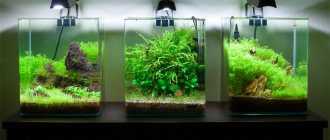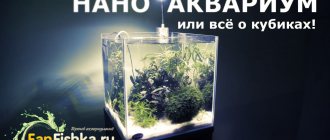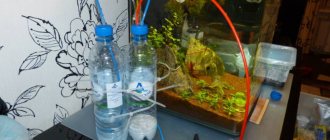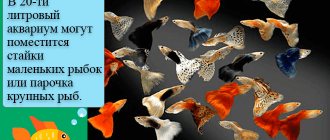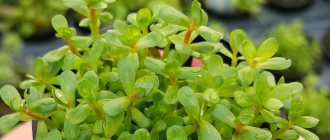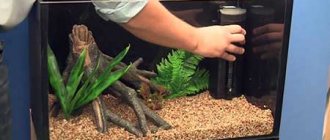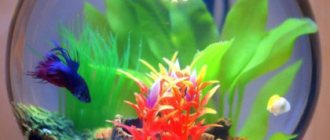5
(4)
Recently, nano aquariums have become an innovation in the aquarium world. This is a separate type of art for which special decorations are created, plants are grown and fish breeds are bred. This trend has captured amateurs and professionals from all over the world and has become incredibly popular.
Description
The meaning of the word “nano” is known to many. Thinking about nanotechnology, you can understand that it means something small. The idea to create a microcosm arose when aquarists tried to make marine reef aquariums smaller. As a rule, in order to recreate a full-fledged marine picture, with anemones, living corals, various invertebrates and marine fish species, a large capacity container is needed. However, over time, aquariums smaller than 300 liters began to appear, which acquired the name “micro-reefs”. Models smaller than 100 liters began to be called “nano reefs”.
Now, the prefix “nano” means a freshwater aquarium, the volume of which is 35 liters or less. Although the name does not indicate the volume itself, but the ability to fully contain fish and plants in it. In most cases, small fish and shrimp become pets.
Livestock[edit]
Fish[edit]
Main article: List of marine aquarium fish species
- Angelfish
- Blennies
- Cardinal
- Clown fish
- Damned
- Acne
- Gobies
- Rabbit fish
- Tang
Invertebrates[edit]
Main article: List of marine aquarium invertebrates
- Coral reed ( Caulastrea furcata
) - Frog coral ( Euphyllia divisa
) - Hammer coral ( Euphyllia ancora
) - Pulse coral (Heteroxenia sp.)
- Brain coral
- Button polyp (Zoanthus sp.)
- Star
polyp (
Briareum violaceum
) - Cleaner shrimp
Care and equipment
It should be borne in mind that the selection of the necessary equipment takes into account the size and volume of the “can”. The most popular containers are 8, 10, 20 and 30 liters. Finding them is not difficult, since pet stores offer a large selection of different shapes and sizes.
The same goes for the cleaning filter and compressor. For such volumes, you can choose a filter at any pet store. To prevent it from cluttering the interior space, it is recommended to pay attention to external models.
With lighting the situation is somewhat more complicated. Ready-made lids that are sold along with the container often do not provide adequate lighting, which would be enough for the growth of strong and healthy plants. Therefore, for a capacity of 35 liters, additional fluorescent lamps will be required. For 10-20 liters, it is enough to purchase a fluorescent table lamp. By changing its height above the water you can adjust the amount of light. The required power is 2-3 W for every 3 liters.
If tropical fish and shrimp become the future pets of the nano tank, you will most likely need a water heater. The best option is an immersion heater with a thermostat.
Difficulties in caring for a nano aquarium are reflected in fluctuations in the pH balance. The small volume makes the water vulnerable to the dissolution of waste products from pets and plants. The situation is aggravated by the lack of regular water changes and leftover uneaten food. A decrease in balance puts a greater burden on the miniature eco-system. This can lead to the death of all living things.
The small volume also affects the lack of temperature stability. Most freshwater fish will not notice small fluctuations, but they can be detrimental to marine life and shrimp. It is important not to allow overheating above 28 degrees. In the hot season, it is better to equip the “jar” with a cooling system and try to maintain a constant temperature.
If you have created a nano sea, then you need to monitor such a parameter as salinity. Water evaporation increases its indicator, and if the aquarium is not equipped with a cooling system and automatic water addition, the load on pets will increase.
Otherwise, care is quite simple. It is enough to follow the following rules:
- Every week it is necessary to replace 25% of the water;
- It is also necessary to monitor the water level and add it in time if it evaporates;
- Plant care - trimming rotten and dry leaves, removing overgrown stems;
- Cleaning the soil with a siphon every one and a half to two weeks;
- Cleaning the walls of the aquarium with a sponge;
- Regular plant nutrition;
- Clean the filter when dirty.
Links[edit]
- ↑
Riddle, Dana (December 7, 2011).
"Special article: Building an aquarium from plywood". Advanced aquarist
. Pomacanthus Publications, LLC. Retrieved December 5, 2014. - "Live Rock".
- Toonen, Robert, Ph.D. and Vee, Christopher. “Experimental comparison of sand and injection systems. Part 1: controlled laboratory dosing experiments.” Advanced aquarist 4.2 (2005)
- ^ab Adams, Jake. “For corals, water flow is more important than light, part V.” Advanced Aquarist V.6.1 (2007). https://www.advancedaquarist.com/2007/1/aafeature/view?searchterm=flow
- ↑
Riddle, Dana (February 14, 2006).
"Feature Article: Temperature and the Reef Aquarium". Advanced aquarist
. Pomacanthus Publications, LLC. Retrieved December 5, 2014. - “What do YOU consider to be a nano-reef?” Nano-Reef.com Community
. Retrieved March 19, 2021. - History of picorifan biology.
- "Water change". Nano-Reef.com Community
. Retrieved March 19, 2021.
Choosing plants
Considering the modest size and sometimes unusual shapes of the “can,” the choice of plants should be approached with special responsibility. Large plants with large leaves and long stems are not planted in the nano world. Also, do not consider fast-growing animals. Otherwise, every few days you will have to monitor their growth and shorten them.
Unpretentious plants would be ideal, for example:
- Anubias;
- Decorative types of mosses (Flame, weeping moss) and ferns;
- Cryptocoryne;
- Dwarf sedge;
- Rotala Wallich;
- Didiplis diandra and others.
Such plants will create a dense carpet, purifying the water and maintaining the balance of the environment. If the aquarist does not mind caring for plants more often and using a CO2 supply, he has a huge selection of decorative options and possibilities. If the substrate contains a sufficient amount of organic matter, there will be no need to use additional carbon dioxide. This is possible provided that finicky plants, such as Hemianthus Cuba, Pogostemon Helferi, etc., are not planted in the nanoworld.
Who can be accommodated?
The choice of inhabitants for a nano aquarium directly depends on its size. Small containers with a volume of up to 8-10 liters are recommended to be used only for growing plants. Such an aquarium will be a wonderful and unusual decoration for your desktop. In addition, it is easy to care for; it is enough to regularly add water and periodically feed the flora with fertilizers.
To add variety to the picture, you can start a colony of shrimp. Their advantage is that they have bright colors (red, blue, striped, yellow, black, etc.). They also help in cleaning the walls by eating harmful algal growths. For this reason, they need to be fed as little as possible. This will help keep the water clean.
You can think about fish if the volume of the nanoworld is 15 liters or more. Small pets should be considered, for example:
- Tetra amanda . Small schooling fish. Twenty liters is enough to accommodate 8-10 individuals;
- Dwarf poecylobricon . They move only in schools, the more of them, the better and more comfortable for the fish;
- Badis red. Peace-loving and calm fish, they feel great even in pairs, but it is better to launch at least 6 individuals;
- Cardinal, neon. They will enliven the aquarium and stand out brightly even in dense thickets;
- Cockerel. Bright and beautiful fish, easy to care for. They do not require a compressor, since they are of the labyrinth type;
- Guppy. An excellent option for beginners. Easy to care for and beautiful;
- Orizias . Suitable for small-capacity aquariums;
- Microassortment of erythromicron . Their size does not exceed 3 cm. Ideal for containers less than 10 liters.
This is not the entire list of suitable fish species. It is important not to overdo it with their number and leave enough free space for comfortable swimming.
Nano aquarium design
To create a unique design and your own underwater world, you will need decorative elements such as driftwood, stones, soil, plants, corals, shells, caves, figurines, etc. The choice depends on the style in which the nano world will be decorated.
There are several styles, which are determined by the following criteria:
Japanese . The decor in this case imitates the landscape, taking into account the philosophy of Zen. It is important to create a composition that will give peace when observing it. The ideas of a rock garden and bonsai are taken as a basis. The main thing is to maintain minimalism and not oversaturate the aquarium with details. Many people use only one type of decor - stones, driftwood or plants. A prerequisite is the use of an odd number and different sizes of elements;
Pseudo-natural . It will require a minimum of financial costs, since the simplest plants and pets are used as decoration. For lighting, it is enough for the “can” to stand on the sunny side of the room (however, the light will need to be covered so that algae does not appear on the walls), or you will have to purchase low-power fluorescent lamps;
Natural (biotope) . The main rule is to recreate an accurate picture of a natural body of water. Plants and animals are carefully selected and a habitat close to natural is created. The purpose of this style is to observe living beings of the same species for research;
Pseudomore . Since the volume of a nano aquarium will not be enough to create marine conditions, you can make an imitation by filling it with fresh water and introducing its inhabitants. Sea shells, artificial corals, stones and soil reminiscent of sea sand are used as decoration. The key elements will be colorful fish, corals and algae. To enhance the effect of sea blue, it is necessary to add backlighting in cold tones to the lighting;
Concept . The idea behind this style is to recreate a decor that suits the owner's interests. For example, if a person is interested in space, you can recreate the surface of Mars. If a nano container is being presented to a baby, then designing his room or using figurines of his favorite characters would be an excellent choice.
General information
A generally accepted division by volume: conventional, large-sized and nano-aquariums has not yet been developed. Tanks for fresh water are considered small, with a capacity of up to 40 liters, for sea water - a maximum of 100 liters. 5-10 liter containers often contain shrimp and one or more small fish. If you want to observe different types of inhabitants, purchase a nano-aquarium with a volume of 20–40 liters.
The containers are covered with glass on top, which prevents water evaporation and fish and shrimp from jumping out.
The best choice is a cubic or rectangular shape of the product. Ultra-transparent glass in round or cylindrical containers gets dirty faster. Fish living in spherical nano-aquariums die prematurely due to the harmful effects of the lens effect .
Nano-aquariums are made using a seamless method from acrylic or less durable glass, using silicone sealants for wall joints. The first case is more practical - the desired temperature regime is maintained longer.
How to start a nano aquarium
Launching a nanoworld is practically no different from launching a regular aquarium. It consists of several stages:
- First of all, plant fertilizer is placed on the bottom in an even layer. It provides them with nutrients so that the aquarium flora has a rich color and healthy appearance;
- Next, soil is poured in a layer of several cm;
- After this, the decor is installed - driftwood, artificial decor, shells, stones;
- The aquarium is filled with water from the tap. It must sit for at least three weeks to complete the nitrogen cycle;
- Plants are planted in the ground;
- A filter and heater are installed.
After the expiration of the term, the ecosystem of the nanoworld returns to normal. Now you can release fish and monitor them during the adaptation period. It is advisable to introduce unpretentious breeds, such as guppies, at first. They are more resilient. Pisces will help stabilize the environment and make it comfortable for living. After a week, you can introduce the remaining, more finicky fish.
This completes the launch. All that remains is to take care of the living creatures and monitor the cleanliness of the aquarium, add fresh water in a timely manner and siphon the soil. High-quality care will help keep the underwater nano world in balance, and your pets will delight you with good health and a beautiful appearance.


